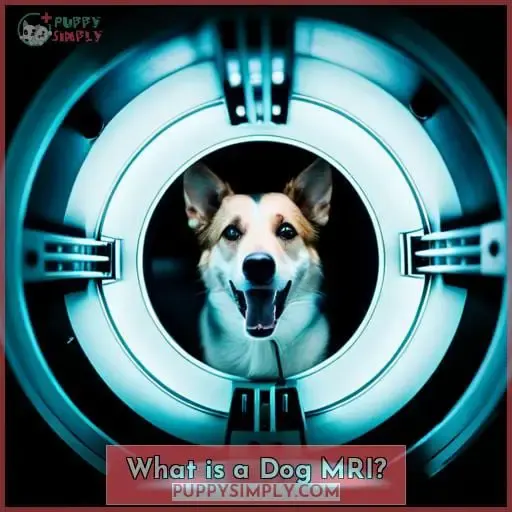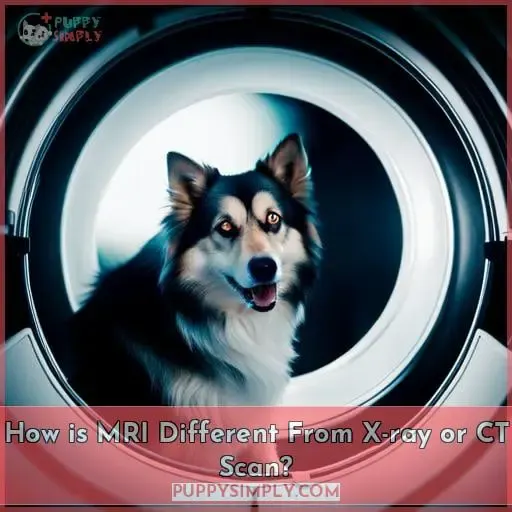This site is supported by our readers. We may earn a commission, at no cost to you, if you purchase through links.
Barking up the wrong tree with your pup’s medical care? Magnetic resonance imaging, or MRI, is the gold standard for diagnosing a range of complicated conditions in dogs. An MRI scan can provide detailed images to help your vet better understand what’s going on inside your pet’s body – and how best to treat it.
But before you book an appointment, you should know: dog MRI cost can vary widely depending on many factors.
Table Of Contents
- Key Takeaways
- What is a Dog MRI?
- How Much Does a Dog MRI Cost?
- What Else Can Affect the Cost of an MRI?
- Will Pet Insurance Cover the Cost of My Dog’s MRI?
- When Do Dogs Require MRIs?
- What Will and Won’t Show Up on an MRI?
- How is MRI Different From X-ray or CT Scan?
- Why is MRI More Expensive for My Dog Than for Me?
- How Do I Choose the Right Dog MRI Provider?
- Frequently Asked Questions (FAQs)
- Conclusion
Key Takeaways
- The cost of a dog MRI can vary widely depending on many factors.
- Pet insurance may cover some or all of the cost of a dog MRI.
- Geographical location and veterinary experience/facility choice can impact the price of a dog MRI.
- Negotiating with insurance companies and researching veterinary care options can help reduce the cost of a dog MRI.
What is a Dog MRI?
You’re curious about a mysterious procedure that could help your beloved pet? An MRI, or Magnetic Resonance Imaging, can provide you with an in-depth look at what’s going on inside. It’s safe and noninvasive; there are no known risks associated with the technology itself.
Preparation for a dog MRI typically includes fasting prior to the scan and sedating them if necessary. The benefits of an MRI for pets include better diagnosis accuracy than other imaging techniques such as X-rays or CT scans, since it provides more detailed images without radiation exposure.
Dog MRI cost varies depending on where you go, but potentially can be covered by pet insurance if your vet offers it–which many do these days! Ultimately, having this diagnostic tool available at veterinary hospitals helps prevent unnecessary surgeries or treatments while saving time and money in the long run.
It provides peace of mind that treatment decisions are based upon accurate information from advanced imaging technologies like MRIs.
How Much Does a Dog MRI Cost?
When it comes to the cost of a dog MRI, there are several factors that must be taken into consideration. Firstly, it’s important to identify what type of MRI needs to be performed. This can range from regular imaging scans, such as T1-weighted or contrast-enhanced images, all the way up to more complex procedures like functional and spectroscopy scans.
Secondly, determine if any additional services, such as anesthetic administration or imaging guidance systems, are included in your quote.
Lastly, note where you will have your scan done since costs vary depending on geographic location and availability of specialized veterinary centers offering MRIs for pets.
What Type of MRI is Being Performed?
Knowing the type of MRI being performed is key to understanding what your pet may be facing, so it’s important to ask questions and get a clear picture. It’s like taking an X-ray into another dimension! Among other factors, consider: MRI safety, scan duration, preparation, and precision; plus reporting accuracy for veterinary use.
Dog MRIs offer peace of mind with accurate diagnoses but can vary in cost depending on location and services needed.
What is Included in the MRI Quote?
Understanding what is included in the MRI quote can help you make an informed decision and get the most value for your money. Factors like MRI preparation, risks, scan quality, anesthesia use, and radiologist experience are all essential components to consider when evaluating potential costs.
Magnetic resonance imaging (MRI) offers higher-quality images than traditional X-rays but may require more expensive high-field MRIs or pet MRIs depending on the situation at hand. Make sure to ask questions about the details of a particular MRI scan so that you understand all of its associated costs before committing to it.
What is the Geographic Location?
The geographic location of the MRI scan can have a significant impact on its cost. Prices vary widely between states and cities – for example, an average scan could be twice as much in some parts of California than elsewhere.
When researching dog MRI costs, compare geographic variations, consider regional pricing structures, and factor in veterinary involvement to get the best value.
What Else Can Affect the Cost of an MRI?
Aside from the type of scan and services required, other factors can contribute to the final cost of your pet’s MRI. Geographic differences, quality assurance protocols, and varying types of MRI equipment all play a role in determining price.
Equipment costs also factor into total pricing; more advanced machines will typically produce higher-quality images but come with a heftier price tag. Veterinary experience is another variable that should be taken into consideration.
Some vets specialize in this particular imaging modality while others may not have as much expertise operating large machines like those used for MRIs or CT scans. Finally, remember that prices often vary depending on which veterinary facility you choose for your pet’s exam.
So make sure to do research beforehand to find an option best suited for both you and your furry friend! Pet owners know it’s important to ensure their pet gets quality care at an affordable rate – so keep these tips in mind when looking around for the right place offering MRIs.
Will Pet Insurance Cover the Cost of My Dog’s MRI?
Will your pet insurance cover the MRI bill for your furry companion? Depending on the policy, it may cover some or all of the costs associated with this type of imaging.
- Evaluate Pet Insurance Policies: Check what is covered in policies and determine which one works best for both you and your dog’s health needs.
- Research Veterinary Care Options: Find a vet who specializes in MRI technology and offers competitive rates based on geographic location.
- Look Into Safety Measures Used During MRIs: Make sure any facility offering scans is up-to-date on safety protocols used during exams to minimize risks associated with anesthesia use during MRIs.
- Consider Negotiating With Your Insurance Company: Talk to customer service reps from insurance companies about potential discounts or payment plans that could lower costs significantly over time.
Taking these steps will ensure quality care while keeping prices down; something every pet owner wants when looking into diagnostic testing options like magnetic resonance imaging (MRI).
When Do Dogs Require MRIs?
Are you wondering when your furry friend may need an MRI? An MRI is a non-invasive scan that can help diagnose soft tissues, spinal cord, and other internal issues. Signs of need include changes in behavior, mobility, or eating habits. If blood tests show elevated levels of certain enzymes related to organ failure or injury, then an MRI could be recommended for further diagnostic accuracy.
The benefits of this type of imaging are immense. It allows veterinarians to get a detailed look inside the body without having any invasive procedures done on your pet. Proper preparation tips should be followed prior to the appointment, which includes making sure there is enough time allotted for pain management if necessary after the scan has been completed.
When weighing up dog MRI cost against its potential medical benefits, it’s important to remember that these scans can often provide invaluable insight into what might be going wrong with our beloved companions.
What Will and Won’t Show Up on an MRI?
An MRI scan can provide a detailed look at your furry friend’s internal anatomy, allowing you to identify any potential issues before they become serious. There are many types of MRI scans available that use different imaging techniques and come with varying levels of risk factors.
Knowing the safety precautions necessary for each type is crucial in order to ensure your best friend gets the care they need without unnecessary sedation or harm.
The complexity of the required images also affects how much an MRI costs, as does the considerable cost associated with owning and operating an MRI machine itself.
- MRI Types
- Imaging Techniques
- Risk Factors
- Safety Precautions
When deciding whether or not an MRI is right for your pet, weigh up both its benefits and risks so that any decision made takes into account both their physical wellbeing as well as financial considerations too!
How is MRI Different From X-ray or CT Scan?
You may have heard of an MRI, but what does it mean? An MRI stands for Magnetic Resonance Imaging and is a type of diagnostic test that can provide detailed images of the internal structures of your dog.
- The magnetic field used by an MRI allows doctors to get more accurate pictures than with X-ray imaging.
- MRIs also require no radiation exposure, making them safer than other types of imaging tests such as CT scans or X-rays, which use ionizing radiation.
- While MRIs are typically more expensive than other imaging techniques due to the cost associated with owning and operating an actual machine, they often result in fewer repeat visits for further testing due to their accuracy and detail level when compared against regular diagnostic tools like X-rays or ultrasounds.
- MRIs also allow doctors to take three-dimensional pictures so they can better identify any issues before they become serious problems requiring surgery or long-term treatment plans.
Finally, while risk factors do exist (such as sedation), taking into consideration both its benefits and risks will help you make informed decisions when investing in this valuable tool for your pet’s health needs!
Why is MRI More Expensive for My Dog Than for Me?
Facing a potential MRI for your furry friend can be daunting, especially when considering the cost. It’s important to understand why MRIs are more expensive than other imaging tests such as X-rays and CT scans, as it will help you make an informed decision on whether this diagnostic tool is right for your pet.
The fiscal impact of MRI testing is largely due to its accuracy. Since no radiation exposure is needed during the procedure and various types of tissues can be scanned with better tissue resolution thanks to radio waves instead of X-ray beams, doctors are able to get much clearer images that provide a more specific diagnosis.
Additionally, contrast agents used in some types of MRI scans may also contribute towards increased costs depending on the scan quality desired by medical professionals operating these machines.
Finally, if general anesthesia or hospital stay becomes necessary during or after an exam respectively, those fees add up too!
By understanding both its benefits and risks associated with obtaining a Magnetic Resonance Imaging test for your four-legged companion, however, you’re one step closer toward making an educated healthcare choice that ensures their safety while giving them access to top-notch diagnostics.
How Do I Choose the Right Dog MRI Provider?
Choosing the right MRI provider for your dog is a crucial decision. Before making any decisions, it’s important to compare prices and vet selection carefully. Additionally, consider the imaging technology used by each provider as well as the diagnostic accuracy they offer in order to determine which one can provide high-quality images with greater precision.
Here are some tips on what you should look out for when selecting an MRI provider:
- Price comparison – Compare different providers and choose one that provides quality service at an affordable cost.
- Vet selection – Look into their credentials and experience in veterinary medicine before entrusting them with your pet’s healthcare needs.
- Imaging technology – Make sure that they use advanced imaging technologies such as digital radiography or computerized tomography scans (CT), along with Magnetic Resonance Imaging (MRI).
- Diagnostic accuracy – Ensure that the facility has a wide range of scanners so you can get accurate results about various brain issues affecting your pet quickly without compromising on image quality or safety measures employed during testing procedures such as pain management protocols, etc.
By taking these factors into consideration, you will be able to select a reliable medical facility offering high-quality diagnostic services accurately pinpointing the cause of distress in dogs!
Frequently Asked Questions (FAQs)
How long does a dog MRI take?
A dog MRI typically takes about an hour, but it can feel like a lifetime if your pup isn’t accustomed to the process.
What are the risks associated with having a dog MRI?
Having a dog MRI can be risky, as it involves your pup being exposed to strong magnetic fields and radiation. Although rare, potential risks could include adverse reactions to the sedative used during the procedure or injury due to movement within the scanner.
Take steps such as ensuring that your vet is experienced with MRIs before proceeding.
How should I prepare my dog for an MRI?
Prepare your dog for an MRI by acclimating them to the sounds they will hear, ensuring their environment is comfortable, and introducing them to the machine prior to scanning. Provide treats during all steps of preparation and use positive reinforcement techniques when appropriate.
Is there a way to make a dog MRI less expensive?
Investigate ways to save money on your dog’s MRI. Ask the vet if they offer discounts, shop around for a more affordable clinic, or consider financing plans.
Are there any alternatives to a dog MRI?
Surprisingly, up to 80% of dog MRI results can be obtained using a CT scan. These scans are much less expensive and offer an alternative solution for owners seeking answers about their pet’s health.
Conclusion
In conclusion, getting a dog MRI can be expensive, but it’s an important procedure when it comes to diagnosing certain illnesses or health conditions. The cost of a dog MRI can vary greatly depending on the type of MRI, what is included in the quote, and the geographical location.
It’s estimated that a dog MRI can cost anywhere from $500 to $5,000. Pet insurance can help defray the cost of the MRI, but it’s important to read the policy carefully to make sure that the procedure is covered.
Ultimately, choosing the right provider for your dog’s MRI is key to getting the best results for the best price.
















